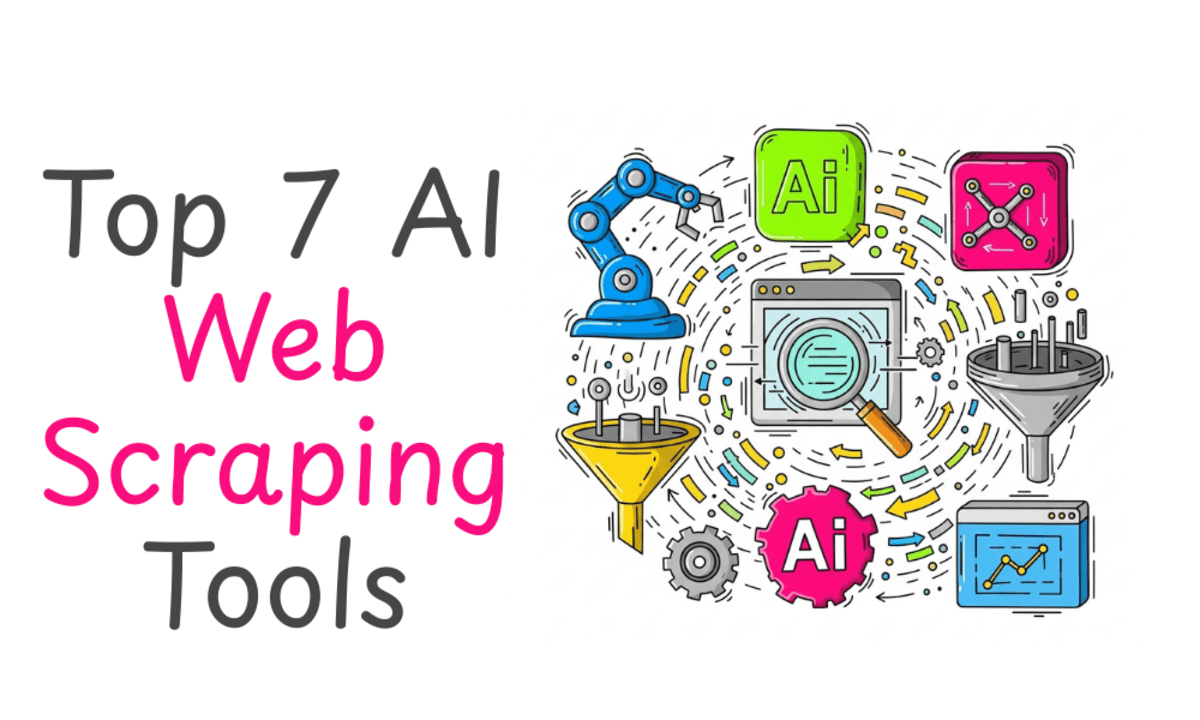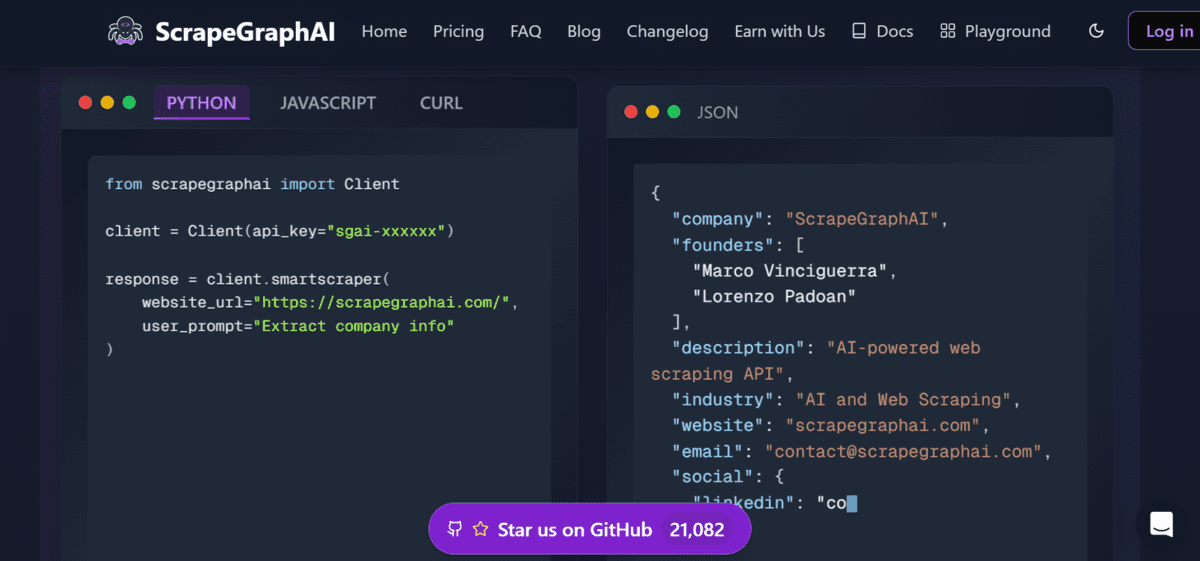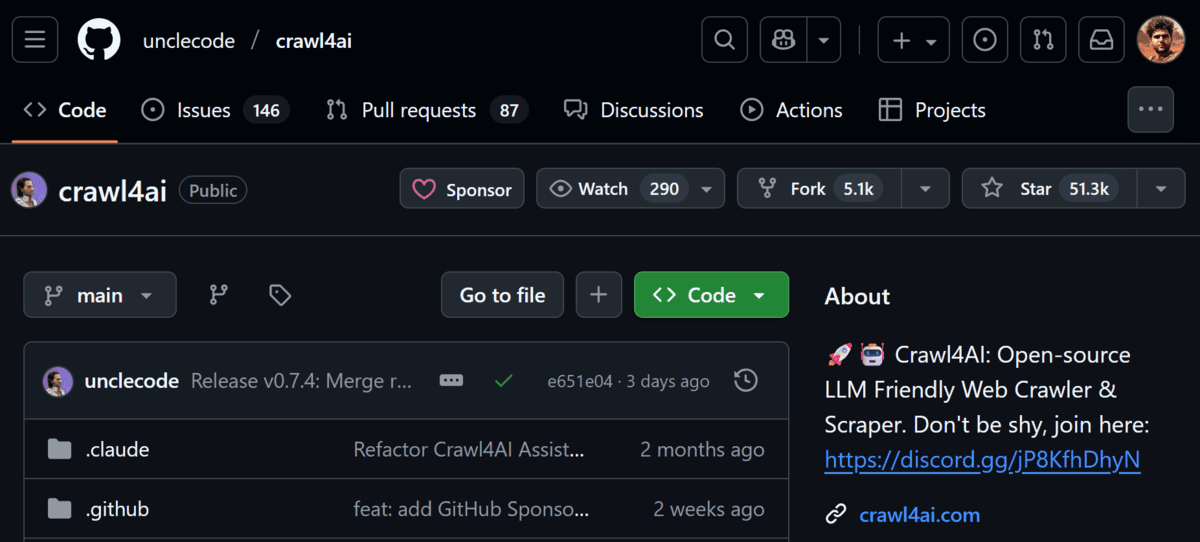Jobs & Careers
Top 7 AI Web Scraping Tools


Image by Author | Gemini
# Introduction
Web scraping has become a vital skill in the data-driven world, especially with the rise of large language models (LLMs), where high-quality and factual data from the internet forms the backbone of their performance. Beyond powering AI, web scraping is widely used for tracking financial markets, monitoring website migrations, automating UI testing, and much more. With the right expertise, it can even be a highly lucrative career.
In this article, we will explore some of the top AI-powered web scraping tools that make the process effortless. Many of these tools come with built-in LLM integrations, enabling you to extract exactly the information you need from the website with minimal effort.
# Top 7 AI Web Scraping Tools
// 1. Firecrawl
Firecrawl is an API that crawls any URL (and its subpages) to deliver clean, LLM-ready markdown, no sitemap needed. It supports scraping, mapping, searching, and extracting structured data, while handling proxies, anti-bot systems, and dynamic content for you. With SDKs, LLM and low-code integrations, plus self-hosting options, Firecrawl makes web data extraction fast, reliable, and effortless.


// 2. ScrapeGraphAI
ScrapeGraphAI is an LLM-powered web scraping suite that makes it easy to extract structured data from any website or HTML content. With services like SmartScraper, SearchScraper, SmartCrawler, and Markdownify, it’s perfect for AI applications, data analysis, dataset creation, and platform building. With seamless integrations into LangChain and LlamaIndex, plus production-ready SDKs, ScrapeGraphAI helps you build smarter AI agents, research pipelines, and data-driven applications effortlessly.


// 3. Crawl4AI
Crawl4AI is an open-source project available on GitHub, designed for fast and efficient web crawling tailored for large language models, AI agents, and data pipelines. It provides clean markdown, structured data extraction, advanced browser control, and high-performance parallel crawling, all without requiring API keys or imposing paywalls.
The new adaptive web crawling feature utilizes intelligent algorithms to determine the optimal time to stop, enhancing data collection by making it smarter and more efficient.


// 4. Octoparse
Octoparse is a user-friendly web scraping platform that allows for easy data extraction without any coding skills required. Its drag-and-drop interface is ideal for beginners and non-technical users. The platform features AI-powered field detection, hundreds of pre-built templates, and offers cloud-based automation for round-the-clock scraping with flexible export options. Advanced functionalities such as IP rotation, CAPTCHA solving, and AJAX handling enhance its versatility, while OpenAPI support enables seamless integration with other tools.


// 5. Browse.AI
Browse.AI is a no-code web scraping tool that lets you build robots to mimic human browsing and extract data, no technical skills required. With point-and-click setup, AI-powered monitoring, and 200+ prebuilt robots, it enables fast, reliable data collection from websites and subpages. Cloud-based automation, real-time alerts, and integrations with Google Sheets, Airtable, Zapier, and 7,000+ apps make it ideal for business users.


// 6. ScrapingBee
ScrapingBee is a powerful web scraping API designed to help you extract data without the risk of being blocked. It manages headless browsers, automatically rotates proxies, and supports AI-powered extraction, allowing you to describe the data you need in plain English. With built-in JavaScript rendering, ScrapingBee can handle modern frameworks like React, Vue, and Angular. It also offers features such as custom JavaScript execution, screenshots, and SERP scraping.


// 7. Apify
Apify is a full-featured web scraping and automation platform that lets you build, run, and share scrapers (called Actors) in the cloud. It provides everything you need for large-scale data extraction: smart proxy rotation to avoid blocking, flexible storage and export options, scheduling, monitoring, and team collaboration. With official SDKs (JavaScript, Python), a powerful API, and a CLI, Apify integrates seamlessly into any workflow. It also offers Crawlee (an open-source scraping library), fingerprinting tools, and ready-made Actor templates to speed up development.


# Final Thoughts
AI-powered web scraping tools make data extraction much easier. They can handle complex websites with multiple layers of navigation and still deliver the information you need quickly. The tools mentioned in this article require little to no coding experience, making them beginner-friendly and accessible to non-technical users. With their intuitive interfaces and simple APIs, anyone can extract valuable information or build data pipelines effortlessly.
Abid Ali Awan (@1abidaliawan) is a certified data scientist professional who loves building machine learning models. Currently, he is focusing on content creation and writing technical blogs on machine learning and data science technologies. Abid holds a Master’s degree in technology management and a bachelor’s degree in telecommunication engineering. His vision is to build an AI product using a graph neural network for students struggling with mental illness.
Jobs & Careers
Larry Ellison Tops Elon Musk to Become World’s Richest Person After Oracle Stock Surge

Larry Ellison has become the world’s richest person, overtaking Tesla chief Elon Musk after an unprecedented rally in Oracle’s stock added more than $100 billion to his fortune in a single day.
The 81-year-old Oracle co-founder and chief technology officer saw his net worth climb to around $393 billion, according to the Bloomberg Billionaires Index. The leap dethroned Musk, whose wealth has been under pressure amid a slide in Tesla shares and the volatile performance of his other ventures.
The trigger came from Oracle’s fiscal first-quarter results which revealed explosive growth in the company’s artificial intelligence-driven cloud business.
Investor enthusiasm sent Oracle’s stock soaring more than 40 percent, pushing the software giant’s market value up by nearly $200 billion in a single session.
Analysts described the rally as one of the most dramatic in the company’s history, fueled by a swelling order book for AI cloud services that is now approaching half a trillion dollars
Oracle Corporation reported fiscal first-quarter 2026 revenue of $14.9 billion on Tuesday, up 12% year-over-year in US dollars and 11% in constant currency.
Cloud revenue, including infrastructure and applications, rose 28% to $7.2 billion. Infrastructure-as-a-Service (IaaS) revenue grew 55% to $3.3 billion, while Software-as-a-Service (SaaS) applications revenue increased 11% to $3.8 billion. Within SaaS, Fusion Cloud ERP revenue was $1 billion, up 17%, and NetSuite Cloud ERP revenue also reached $1 billion, up 16%.
Oracle CEO Safra Catz said the company has signed major cloud contracts with top AI players such as OpenAI, xAI, Meta, NVIDIA, and AMD. “At the end of Q1, remaining performance obligations, or RPO, now to $455 billion. This is up 359% from last year and up $317 billion from the end of Q4. Our cloud RPO grew nearly 500% on top of 83% growth last year,” she said.
“MultiCloud database revenue from Amazon, Google and Microsoft grew at the incredible rate of 1,529% in Q1,” said Ellison. “We expect MultiCloud revenue to grow substantially every quarter for several years as we deliver another 37 datacenters to our three Hyperscaler partners, for a total of 71.”
Eliision added that next month at Oracle AI World, the company will introduce a new Cloud Infrastructure service called the ‘Oracle AI Database’ that enables customers to use LLMs of their choice, including Google’s Gemini, OpenAI’s ChatGPT, xAI’s Grok, etc., directly on top of the Oracle Database to easily access and analyse all their existing database data.
Oracle also raised its forecast for Oracle Cloud Infrastructure, projecting 77% growth this fiscal year to $18 billion, up from an earlier estimate of 70%.
Over the longer term, the company expects cloud infrastructure revenues to accelerate dramatically, targeting $32 billion next year and as much as $144 billion within five years.“We now expect Oracle Cloud Infrastructure will grow 77% to $18 billion this fiscal year and then increase to $32 billion, $73 billion, $114 billion and $144 billion over the following 4 years,” said Catz.
The post Larry Ellison Tops Elon Musk to Become World’s Richest Person After Oracle Stock Surge appeared first on Analytics India Magazine.
Jobs & Careers
Pune-Based Astrophel Aerospace Develops Indigenous Cryogenic Pump for Rocket Engines

Astrophel Aerospace, a space tech startup from Pune, has developed an indigenous cryogenic pump designed to power its upcoming Astra C1 rocket engine. The pump, capable of spinning at 25,000 revolutions per minute, is undergoing testing at Indian Space Research Organisation (ISRO) facilities.
The company plans to upgrade it into a turbopump for integration into its first and second stage engines by late 2026.
Astrophel announced the development, stating that it positions the firm among the first private Indian startups to build an in-house cryogenic pump. “This milestone is a testament to how India can indigenously develop advanced propulsion technologies at a fraction of global costs,” Suyash Bafna, co-founder of Astrophel Aerospace, said.
The company recently raised ₹6.84 crore (~$800,000) in a pre-seed funding round to develop a reusable semi-cryogenic launch vehicle and missile-grade guidance systems.
Testing and Global Plans
The company is also preparing to sign a memorandum of understanding with a US-based partner (unnamed them as of now) and exploring global collaborations for export opportunities at the sub-component level. These efforts aim to meet rising demand in both the space sector and industries such as oil and gas, which use cryogenic liquids.
According to Astrophel, the pump, though the size of a one-litre bottle, produces 100 to 150 horsepower, equivalent to a family car. The turbopump version will scale this to 500 to 600 horsepower for larger launch vehicles.
“ISRO’s certification will validate not just our pump, but India’s ability to innovate world-class space hardware with global export opportunities,” Bafna added.
Astrophel’s announcement comes as India works to expand its space economy from $8.4 billion in 2022 to $44 billion by 2033, aiming to capture 8% of the global market.
“This milestone represents the culmination of years of frugal engineering and is a stepping stone toward India’s first privately developed gas generator cycle,” Immanuel Louis, co-founder of Astrophel Aerospace, said.
The post Pune-Based Astrophel Aerospace Develops Indigenous Cryogenic Pump for Rocket Engines appeared first on Analytics India Magazine.
Jobs & Careers
Esri India, Dhruva Space Partner to Expand Satellite Data Access

Sanjana Gupta
An information designer by training, Sanjana likes to delve into deep tech and enjoys learning about quantum, space, robotics and chips that build up our world. Outside of work, she likes to spend her time with books, especially those that explore the absurd.
-

 Business2 weeks ago
Business2 weeks agoThe Guardian view on Trump and the Fed: independence is no substitute for accountability | Editorial
-
Tools & Platforms4 weeks ago
Building Trust in Military AI Starts with Opening the Black Box – War on the Rocks
-

 Ethics & Policy1 month ago
Ethics & Policy1 month agoSDAIA Supports Saudi Arabia’s Leadership in Shaping Global AI Ethics, Policy, and Research – وكالة الأنباء السعودية
-

 Events & Conferences4 months ago
Events & Conferences4 months agoJourney to 1000 models: Scaling Instagram’s recommendation system
-

 Jobs & Careers2 months ago
Jobs & Careers2 months agoMumbai-based Perplexity Alternative Has 60k+ Users Without Funding
-

 Podcasts & Talks2 months ago
Podcasts & Talks2 months agoHappy 4th of July! 🎆 Made with Veo 3 in Gemini
-

 Education2 months ago
Education2 months agoMacron says UK and France have duty to tackle illegal migration ‘with humanity, solidarity and firmness’ – UK politics live | Politics
-

 Education2 months ago
Education2 months agoVEX Robotics launches AI-powered classroom robotics system
-

 Funding & Business2 months ago
Funding & Business2 months agoKayak and Expedia race to build AI travel agents that turn social posts into itineraries
-

 Podcasts & Talks2 months ago
Podcasts & Talks2 months agoOpenAI 🤝 @teamganassi

